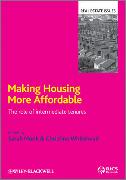Making Housing More Affordable
BücherAngebote / Angebote:
On [so many] aspects of the intermediate housing debate, this report sheds important light. I conclude with congratulations to the authors: their book will raise the quality of discussion on this hugely important topic at exactly the moment when...politicians and practitioners need the evidence and the analysis to decide where next to go with tomorrow's 'intermediate housing'.
Lord Richard Best OBE, President of the Local Government Association
Affordable housing is a growing element in both national and international agenda to achieve sustainable housing markets and adequate standards for all.
The movement away from traditional, rent-based approaches for meeting the housing needs of those on modest incomes has taken on new momentum in the latest economic cycle.
Making Housing More Affordable: the role of intermediate tenures answers key questions concerning affordable housing and low cost home ownership, and asks whether these intermediate tenures have the potential to play a longer-term role in achieving sustainable housing markets.
The editors - the two leading academics in the field - have brought together the work of top international researchers to clarify the principles on which the development of affordable housing and intermediate tenures has been based, to analyse the policy instruments used to implement these ideas, and to make a preliminary assessment of their longer term value to households and governments alike.
Drawing extensively on experience of the intermediate housing market in England, together with examples of policies which have been implemented across the world, the book examines both the challenges and the achievements of governments in providing an intermediate market oriented towards the fundamental goal of 'a decent home for every household at a price within their means'.
The first section of the book outlines the principles and practice of intermediate housing and examines the instruments and mechanisms by which it has been provided internationally. The next section estimates who might benefit from being in intermediate housing and projects the take-up of different products in the future. Section III examines the supply side and Section IV introduces some case studies outlining who gets what. The final section looks at how effectively the intermediate market operates over the economic cycle.
The invaluable integrative framework offered here, together with analysis of this relatively new area of policy, makes the book essential reading for all levels of government and housing market analysts, housing providers, property developers, real estate financiers and lenders as well as those involved in regeneration projects and sustainable communities.
Folgt in ca. 15 Arbeitstagen




